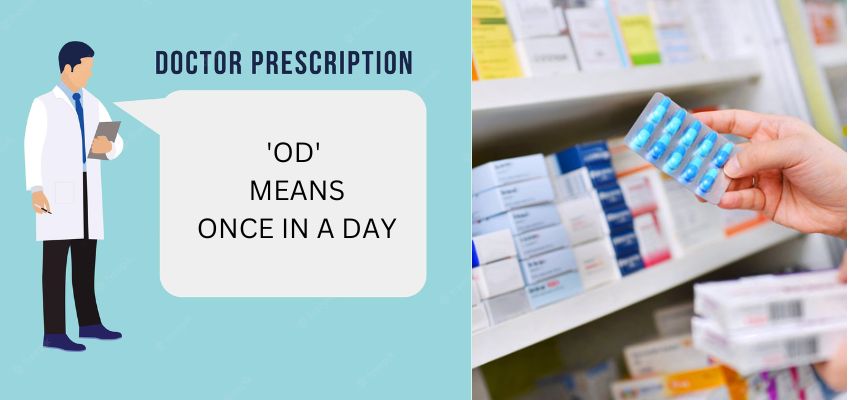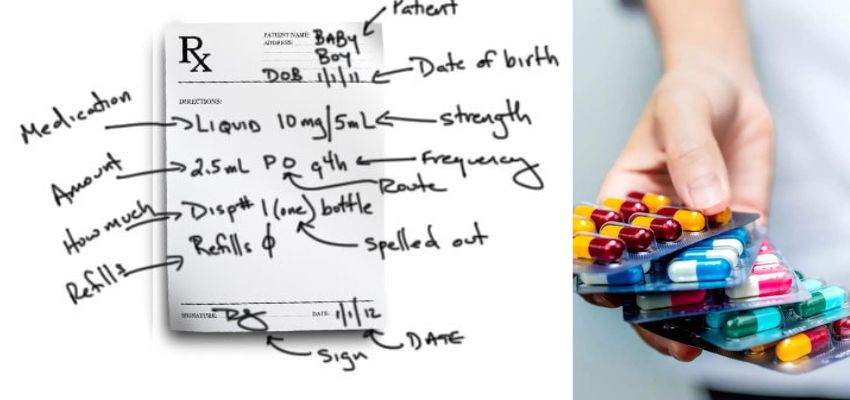Prescriptions can be sometimes confusing to decipher, with a range of medical words and abbreviations. Among these, the abbreviation ‘od’ stands out as it carries multiple meanings depending on the context. However, in the prescription world ‘od’ typically signifies ‘once in a day’.
In this blog, we will explore the meaning of ‘od’ terminology and shedding light towards its significance in healthcare.
Understanding the Prescription Jargon
Medical professionals often use latin words in their prescriptions to convey special meanings and instructions. These abbreviations ensure the accurate communication between a doctor and a pharmacist.
The term ‘od’ mentioned in doctor prescription format comes from the latin word “omni die” which means ‘everyday’. It simplifies the dosing instruction, indicating that prescribed medicine should be taken every day or you can say once in 24 hours.
The importance of dosage instruction
Accurate and clear dosage instructions are crucial for patients to follow according to their treatment plans.
By specifying ‘od’ in a prescription, the healthcare provider gives clarity to optimize the medications effectively.
Special note: In case you want to understand eye prescription chart visit here.
Here are key reasons why dosage instructions are important:
- Safety: Proper dosage instructions ensure the safe and effective use of medications. The prescribed dose is determined based on factors such as the patient’s age, weight, medical condition, and overall health. Following the recommended dosage helps prevent underdosing, which may lead to lack of efficacy, or overdosing, which can result in adverse effects or toxicity.
- Treatment success: Accurate dosage instructions are essential for the successful management of medical conditions. Different conditions require different doses and frequency of medication.
- Patient compliance: Patients are more likely to adhere to their medication when they have a clear understanding of how much medication to take and when. This improves treatment effectiveness and reduces the risk of treatment failure or disease.
- Minimizing medication errors: Patients who carefully follow these instructions reduce the risk of accidental overdosing or underdosing, ensuring the medication is taken correctly.
- Avoiding Drug Interactions: Certain medications may interact negatively when taken together, leading to reduced efficacy or increased side effects
Know more about- tds meaning in prescription
Factors Influencing ‘od’ Prescription
Several factors influence the decision to prescribe medications ‘once in a day’:
- Drug- Half Life: Medications with a longer half-life are more likely to be prescribed once a day. A drug’s half-life refers to the time it takes for half of the medication to be eliminated from the body. Drugs with a longer half-life maintain therapeutic levels in the bloodstream for an extended duration, allowing for once-daily dosing.
- Pharmacokinetics: The way a drug or a medicine is absorbed, metabolized and excreted by the body influences the dosing instructions.

- Patient compliance: When patients find it easier to consume, it increases the likelihood of successful outcomes in a short span of time.
- Condition and Treatment: The type and severity of the medical condition being treated also influence the frequency of medication dosing. Some conditions require higher doses or multiple daily administrations, while others can be effectively managed with once-daily medications.
You may like to know- bd meaning in prescription
Common Medical Condition in which ‘od’ is Written
‘OD’(once in a day) is a common dosage instruction used in various medical conditions.
Here are some examples of medical conditions where ‘od’ is used:
- Hypertension(High blood pressure): Many antihypertensive medications are prescribed to be taken once a day. These medications help control blood pressure levels and reduce the risk of cardiovascular complications. You should also consider reading about butter fruit benefits here and its health benefits.
- High-cholesterol: Medications which are used to lower cholesterol levels, they help manage lipid levels and reduce the risk of heart diseases.
- Diabetes: Medications prescribed once daily for diabetes help to control blood sugar levels in the body.
- Thyroid disorders: Thyroid replacement therapy is often prescribed once a day to manage conditions.
- Allergic Reactions: They are commonly consumed once in a day to relieve symptoms of allergy, itching, sneezing or running nose.
- Asthma: Maintenance medications for asthma are prescribed once a day to control symptoms and asthma attacks.
- Chronic pain: Pain medications such as opioids or anti-inflammatory drugs may be prescribed once in a day to promote pain relief. Have a look at best tablet for headache in india here to choose from in case you are looking for headache treatment instantly.
- Mood disorders: Some antidepressant or anxiety pills are often taken once to manage conditions like depression or bipolar disorder.
CONCLUSION
Prescription essentials are essential for patients to safely and effectively manage their medications.When a prescription indicates “once in a day“, it means that the prescribed dose should be taken once within a 24-hour period.
Also read about the best eye lenses brand in india here.
Dosage instructions are of paramount importance in medication management. They ensure the safe and effective use of medications, promote patient compliance, minimize errors, and contribute to successful treatment outcomes.
Always remember to follow the instructions provided by your healthcare provider or pharmacist regarding your specific medications. They will consider your individual needs and provide you with the most appropriate dosing criteria.
Here are the best Vomiting tablets in india